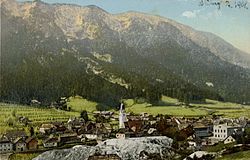Bad Bleiberg
| Bad Bleiberg | ||
|---|---|---|

Bad Bleiberg with Mt. Dobratsch, about 1908
|
||
|
||
| Location within Austria | ||
| Coordinates: 46°38′N 13°40′E / 46.633°N 13.667°ECoordinates: 46°38′N 13°40′E / 46.633°N 13.667°E | ||
| Country | Austria | |
| State | Carinthia | |
| District | Villach-Land | |
| Government | ||
| • Mayor | Gunnar Illing (ULB) | |
| Area | ||
| • Total | 44.8 km2 (17.3 sq mi) | |
| Elevation | 902 m (2,959 ft) | |
| Population (1 January 2016) | ||
| • Total | 2,333 | |
| • Density | 52/km2 (130/sq mi) | |
| Time zone | CET (UTC+1) | |
| • Summer (DST) | CEST (UTC+2) | |
| Postal codes | 9530, 9531 | |
| Area code | 04244 | |
| Website | www.bad-bleiberg.at | |
Bad Bleiberg (Slovene: Plajberk pri Beljaku) is a market town in the Villach-Land District of Carinthia, Austria. Originally a mining area, especially for lead (German: Blei), Bad Bleiberg today due to its hot springs is a spa town. Bad Bleiberg is situated west of the district's capital Villach in a high valley on the northern slope of the Dobratsch massif, part of the Gailtal Alps mountain range. It consists of the Katastralgemeinden Bleiberg and Kreuth.
King Henry II of Germany granted the area around Villach to the newly created Diocese of Bamberg at the Frankfurt synod of 1 November 1007, together with other Carinthian estates like Griffen or the Canal Valley around Tarvisio. When under Emperor Frederick II Bamberg evolved to a Prince-Bishopric, the territories became ecclesiastical exclaves within the territory of the medieval Duchy of Carinthia. In 1759 the Bamberg estates were finally acquired by Empress Maria Theresa and incorporated into Habsburg Carinthia.
...
Wikipedia


